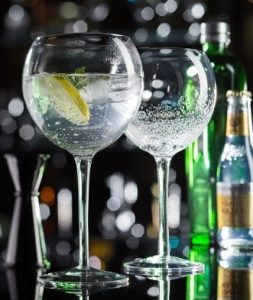Like those in the catering and hospitality industries themselves, glassware trends are always changing; brands are continuously coming up with new innovations in design that compliment an operator’s drink service than ever before. Because of the current trends hitting hard in the drink sector, particular types of glassware have becomes especially popular.
Due to the explosion of gin in recent years, copa de balon (balloon) glasses have become as ubiquitous in your local pub as a tulip beer glass. One notable benefit is their ability to hold plenty of ice and garnish, without intruding on the volume of drink the glass can hold. In addition, the size and style of the glass gives an element of sophistication to not only the drink it holds, but also the one drinking from it.

With the rise in gin popularity, cocktails have enjoyed a resurgence too. As such, this drinks trend has resulted in an influx of unique and unusual styles of glass. Two of the most notable glasses to have found vogue status are those with a skull or tiki design. Being fun and quirky styles compliments the flamboyant and colourful nature of cocktails, making them the perfect candidate for your customers next Instagram post.
A fashion we are predicting to make a comeback over the course of 2020 is metal rimmed glasses. With premiumisation quickly establishing itself as one of the key trends for next year, we expect to see metal rimmed glasses come back to the forefront of the beverage scene. Gold and silver will both be prevalent colour options, but one new addition will be gun-metal grey. This colour scheme will complement the urban and rustic themes which became popular during 2019 whilst adding a premium element.

Substance, or glass make up, is an important factor which shouldn’t be ignored when sourcing glassware for your pub or restaurant. Purchasers should always review the functional qualities of any glass they look to source. Properties such as anti-chip guarantees, thermal shock resistant, dishwasher safe and microwave safe must be considered when looking to buy your next everyday use glassware as they all increase a glass’s working lifespan. Equally, glass thickness should also be inspected as those too thick will be heavy and cumbersome, leaving it prone to being dropped by inebriated patrons. Conversely, if the glass is too thin, you risk breakages due to the fragility and delicate nature of the glass.
Style also plays an equally important part as licensees need to ensure the glasses they are buying match the theme of the establishment. With most eateries taking great pride and investing heavily in their venue décor, it would make sense for tableware and glassware to match and complete the intended aesthetic.With each type of glass being designed for a different drink, ensuring you have the right glass is essential in achieving customer satisfaction. As such, operators should make sure their selection of glassware includes all the necessary styles needed to serve their drinks menu.

Where wines are concerned, the most common collection of glasses include red and white wine glasses with champagne glasses too. Red wine glasses typically have a deeper and larger bowl to allow the flavours and tones within the heavier spirit to be fully appreciated. White wine glasses are normally served in a smaller bowled glass when compared with more full-bodied red alternatives. This is to preserve and deliver the more floral aromas associated with white wine whilst also expressing the higher level of acidity more prominently.
When serving champagne, however we would recommend a champagne wine glass over a flute or coupe. The larger rim, accompanied by a deeper and slightly wider bowl, enables the release of the drink’s scent in a manner not possible with a narrower flute. Due to the amount of dissolved gas in the liquid, once it meets a rough surface, bubbles will begin to form from that point. As such, champagne glasses should be polished and cleaned thoroughly to remove all dirt, dust or fibre. At the centre of the bowl will be a “sparkling point”, which is a small etched area designed explicitly for creating a bubble extravaganza. If cleaned properly, a champagne wine glass should exhibit a single stream of bubbles, rising in a decadent, yet invigorating manner from the middle of the glass.
Moving onto the current king of the beverage world, gin is traditionally served in a Tom Collins glass: tall, uniform and straight forward. You don’t need to be a gin connoisseur to be familiar with this sight, but is there another, more preferential option?

Copa de Balon glasses, like the Botanist range from Utopia, are what gins should be served in. The wider cousin of the red wine glass is better suited to serving spirits as the rounded shape of the goblet helps to keep the scent and flavour of the drink contained within the glass. Equally, the increased volume allows for more ice, keeping drinks cooler for longer whilst also inviting more exotic and prodigious garnishes, opposed to standard lime wedge.

Being delicate yet essential pieces of tableware, operators must also take into account as to how to keep their glassware in top condition. Breakages through rowdy or clumsy patron behaviour is a part of managing an eating establishment, there is little that can be done to mitigate such events. However, there are some practices you can follow to ensure your glasses are kept in optimum condition.
- Handwashing is preferred. We understand a glasswasher can save time, money and man hours, but washing glasses by hand is a much more effective way of preserving their quality and increasing their working life.
- Check the water hardness. Hard water has a high mineral content making it capable of scratching glasses during wash cycles. If you are based in a hard water area and do use a glasswasher look to employ water softener or dishwasher salts.
- Store rim down. Glasses as a rule should be stored rim down, with the exception of stemmed glasses which should be stored base down. The reason for this is the rims of many wine and champagne glasses are the most delicate part.

When looking to replace ad hoc breakages of one or two glasses in a range, then simple small batch orders when necessary are the best port of call. Equally, with each piece of glassware having such a heavy and well-used working life, it is best practice to replace glasses every 3 to 5 years. Naturally, most glass ranges boast superior chip resistance and crack guarantees, especially where the hospitality industry is concerned. As such, it is reasonable to assume operators can stand to use the same glasses for at least 5 years, providing they are well maintained and cleaned. Handwashing extends the working life of glasses compared with glasswashers and so too does proper storage practices of glasses.
However, if an operator is looking to completely overhaul their current glassware, timing is important. Should you wish to replace large portions of your glassware, potentially pair this with new drink options on your menu, or a change in theme. This can be used to generate interest from local customers as well as producing new innovative, photographable options for social media too.


